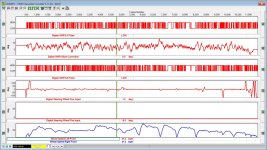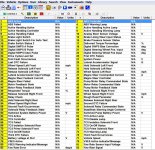Here is 1 C5 owner replacing the SWPS
I just changed my sensor out after receiving the usual 1287 and 1288 DIC messages that anyone reading this thread has seen, and here are my tips. The job took me about 4 hours (working and watching the wall-mount TV in the garage) but I could do it in 90 minutes now that I know exactly what to do and what the nut sizes are. It's technically very simple, but a real pain-in-the-*** as far as working under the dash area.
1. In my opinion, you should make it easy on yourself and remove the left front wheel and the black plastic access panel that is just behind it. That panel is held on by 8 or 9 sheetmetal screws that take a 7mm socket. It only takes minute to remove this panel, and it provides
easy access to the otherwise extremely difficult-to-reach steering shaft bolt/nut. You'll drop the nut or the bolt and have to remove this panel anyway to find it, so do it now. You know how to remove a dang wheel, and you know how to unscrew a handful of sheetmetal screws, so do it!! You can see the head of the bolt thru the wheelwell in this picture.
[IMG alt="Name: Viewthruwheelwell.jpg
Views: 6687
Size: 67.9 KB"]
https://www.corvetteforum.com/forum...l-position-sensor-viewthruwheelwell.jpg[/IMG]
2. The nut gets removed with a 15mm socket. You don't have to hold the head of the bolt, as it has a locking tang that prevents it from turning. You can see this tang in the above photo. You have to turn the steering wheel to get the nut pointing at you for easy removal.
3. If you have Column Lock Bypass, you MUST reverse it to prevent a horrible disaster of having the wheel turned when it's disconnected from the car. Horrible.
The reversal 's easy to do, since you have to remove all the dashboard stuff anyway, which allows ultra-easy access to the CLB connector. The reversal method is to turn the key to On, remove fuse 25, remove the CLB, reattach the original Column Lock connector, reinstall fuse 25, turn key Off and remove it. You should hear the lock do it's little buzz noise (you probably forgot what it sounded like). But wait until you do the
two steps I've listed belowto make it super easy on yourself. Pull fuse 16 (airbag) while you're in the fuse block. In fact, do it early in the process to be safe. I'm not going into the airbag disarming procedure here, but you've been warned.
4. This has not been clearly mentioned in this thread so far: After you remove the knee bolster panel, you then have to remove the black plastic "tray" that is under the column. This tray contains the footwell light. To remove, you pull down gently on the front corners to extract the plastic trim fasteners holding those corners in place. It's easy to do, just pull straight down gently and firmly.
Then, there is a third fastener in the back, and it's one of those flat metal retainers, very similar to what holds a brake rotor onto one wheel stud. I stuck a VERY large screwdriver between the plastic tray and the metal above it and twisted the screwdriver to force the clip down the stud a little ways.
Then once it was a little loose, I could grab it with a needlenose and twist it off.
This is a really dumb place for such a fastener, and as Indy300 has already mentioned, it's about the hardest thing to this whole job!
The light unclips from behind and goes downward thru the tray. You can then manuver it out of the tray and get the tray completely out of your way. Or leave the the light in place and the tray on the floor, your choice.
5. Now you
have to remove the metal frame that holds the white styrofoam plastic knee bolster thingy. The column will not move rearward far enough or come out of the car without removing this thing. This is quickly done by removing the two small black screws on each side with the same 7mm socket you used to remove that wheelwell panel. The bolster drops out of the way and stays attached to the wires that are clipped to it, like this:
[IMG alt="Name: Dashexplosion.jpg
Views: 8113
Size: 95.8 KB"]
https://www.corvetteforum.com/forum...wheel-position-sensor-dashexplosion.jpg[/IMG]
6. Now you can easily do the CLB reversal job with this stuff out of the way.
7. I recommend that you plan on taking the entire column out. It is MUCH easier to replace the sensor with the column out of the car. The sensor is a very tight fit to the steering shaft (by design) and would really be difficult to get it of the bottom of the shaft when it's in the car, IMO.
All you have to do is detach the 5 or 6 electrical connectors (including the sensor connector down at the firewall) before you go to remove the column. Trust me on this--remove the connectors now so you can easily remove the entire wheel/column assembly when you get it unbolted.
8. The four nuts that hold the column in place are a 13mm socket. Remove the firewall nuts first, then one of the upper nuts, and then remove the final upper nut while you keep the column from dropping with your other hand. It's no heavy and won't come crashing down, but you'll want to support it.
9. Set a towel on the concrete so when you remove the column, you can set it down on the wheel without damaging anything.
10 After you get that last upper nut off, the whole column comes right out if you've gotten all the electrical connectors detached. Nothing to it. Super easy. Don't scratch your car with the end of the shaft as you triumphantly carry your column assembly to the towel!!
11. Replacing the sensor takes about 30 seconds.
As removed from car, looking at the dust seal:
[IMG alt="Name: Asremovedfromcar.jpg
Views: 7207
Size: 39.3 KB"]
https://www.corvetteforum.com/forum...el-position-sensor-asremovedfromcar.jpg[/IMG]
Dust seal is easily removed, showing sensor:
[IMG alt="Name: Dustsealremoved.jpg
Views: 7012
Size: 36.6 KB"]
https://www.corvetteforum.com/forum...eel-position-sensor-dustsealremoved.jpg[/IMG]
Sensor is held very snugly on the shaft by those many copper fingers that can be seen in the inside diameter, and by the green housing. This snug fit is why many of us are advising you to remove the column instead of working under the dash. You just lift a retainer tab or two on the green housing and it wiggles right up and off.
[IMG alt="Name: Removingsensor.jpg
Views: 6733
Size: 52.4 KB"]
https://www.corvetteforum.com/forum...heel-position-sensor-removingsensor.jpg[/IMG]
Pop the new sensor in. You'll know where it goes, so don't worry about screwing this up. It's ultra-obvious. Foolproof.
[IMG alt="Name: Newsensorinplace.jpg
Views: 6862
Size: 44.4 KB"]
https://www.corvetteforum.com/forum...el-position-sensor-newsensorinplace.jpg[/IMG]
Now remove the pin. It's totally safe to do so at this point. It just pulls out with a little twist. Voila! Toss the famous pin in the trash....it's done its job.
[IMG alt="Name: Pinremoved.jpg
Views: 7149
Size: 41.7 KB"]
https://www.corvetteforum.com/forum...ng-wheel-position-sensor-pinremoved.jpg[/IMG]
Pop the dust seal back on and you're done with this operation.
[IMG alt="Name: Dustsealbackon.jpg
Views: 6658
Size: 48.1 KB"]
https://www.corvetteforum.com/forum...heel-position-sensor-dustsealbackon.jpg[/IMG]




